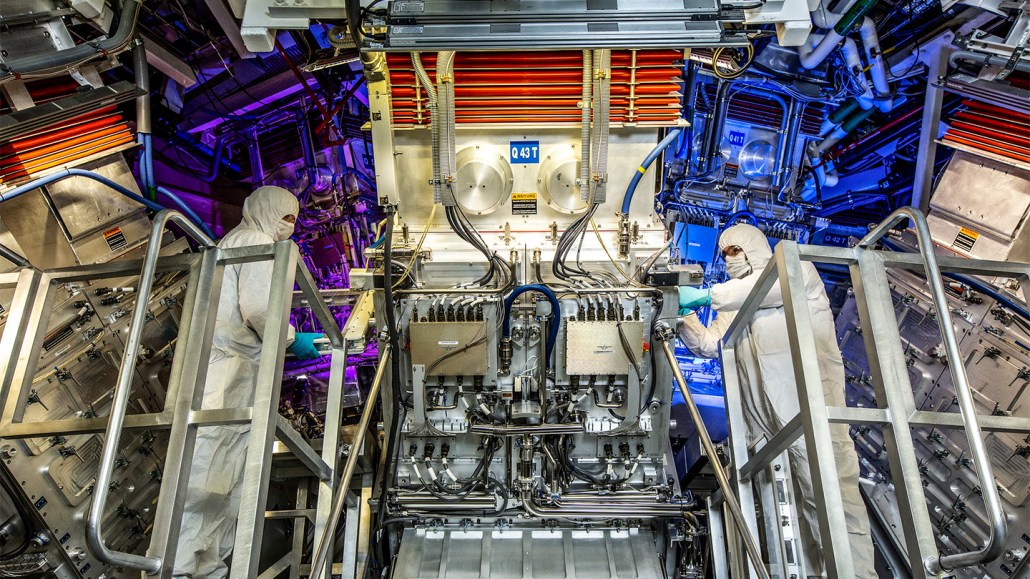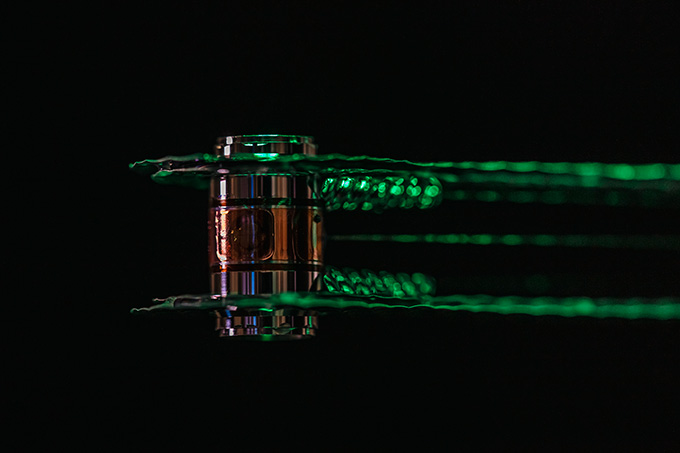
In December 2022, scientists at the National Ignition Facility (pictured) achieved nuclear fusion “ignition,” in which the energy produced by the fusing of atomic nuclei exceeds that needed to kick the fusion off.
Jason Laurea/LLNL
One of nuclear fusion’s biggest advances wouldn’t have happened without some impeccable scientific artistry.
In December 2022, researchers at Lawrence Livermore National Laboratory in California created fusion reactions that produced an excess of energy — a first. In the experiment, 192 lasers blasted a small chamber, setting off fusion reactions — in which smaller atomic nuclei merge to form larger ones — that released more energy than initially kicked them off (SN: 12/12/22). It’s a milestone known as “ignition,” and it has been decades in the making.
Now, researchers have released details of that experiment in five peer-reviewed papers published online February 5 in Physical Review Letters and Physical Review E. The feat demanded an extraordinary level of finesse, tweaking conditions just so to get more energy out of the lasers and create the ideal conditions for fusion.
The work is “exquisitely beautiful,” says physicist Peter Norreys of the University of Oxford. Norreys, who was not involved with the research, compares the achievement to conducting a world-class orchestra: Different elements of the experiment had to be meticulously coordinated and precisely timed.
Scientists also discovered a long-predicted heating effect that could expose the physics of other violent environments, such as exploding stars called supernovas. “People say [physics is] a dry subject,” Norreys says. “But I always think that physics is at the very forefront of creativity,”
The road to nuclear fusion’s big break
Fusion, the same process that takes place in the sun, is an appealing energy source. Fusion power plants wouldn’t emit greenhouse gases. And unlike current nuclear fission power plants, which split atomic nuclei to produce energy, nuclear fusion plants wouldn’t produce dangerous, long-lived radioactive waste. Ignition is the first step toward harnessing such power.
Generating fusion requires extreme pressures and temperatures. In the experiment, the lasers at LLNL’s National Ignition Facility pelted the inside of a hollow cylinder, called a hohlraum, which is about the size of a pencil eraser. The blast heated the hohlraum to a sizzling 3 million degrees Celsius — so hot that it emitted X-rays. Inside this X-ray oven, a diamond capsule contained the fuel: two heavy varieties of hydrogen called deuterium and tritium. The radiation vaporized the capsule’s diamond shell, triggering the fuel to implode at speeds of around 400 kilometers per second, forming the hot, dense conditions that spark fusion.

Previous experiments had gotten tantalizingly close to ignition (SN: 8/18/21). To push further, the researchers increased the energy of the laser pulse from 1.92 million joules to 2.05 million joules. This they accomplished by slightly lengthening the laser pulse, which blasts the target for just a few nanoseconds, extending it by a mere fraction of a nanosecond. (Increasing the laser power directly, rather than lengthening the pulse, risked damage to the facility.)
The team also thickened the capsule’s diamond shell by about 7 percent — a difference of just a few micrometers — which slowed down the capsule’s implosion, allowing the scientists to fully capitalize on the longer laser pulse. “That was a quite remarkable achievement,” Norreys says.
But these tweaks altered the symmetry of the implosion, which meant other adjustments were needed. It’s like trying to squeeze a basketball down to the size of a pea, says physicist Annie Kritcher of LLNL, “and we’re trying to do that spherically symmetric to within 1 percent.”
That’s particularly challenging because of the mishmash of electrically charged particles, or plasma, that fills the hohlraum during the laser blast. This plasma can absorb the laser beams before they reach the walls of the hohlraum, messing with the implosion’s symmetry.
To even things out, Kritcher and colleagues slightly altered the wavelengths of the laser beams in a way that allowed them to transfer energy from one beam to another. The fix required tweaking the beams’ wavelengths by mere angstroms — tenths of a billionth of a meter.
“Engineering-wise, that’s amazing they could do that,” says physicist Carolyn Kuranz of the University of Michigan in Ann Arbor, who was not involved with the work. What’s more, “these tiny, tiny tweaks make such a phenomenal difference.”
After all the adjustments, the ensuing fusion reactions yielded 3.15 million joules of energy — about 1.5 times the input energy, Kritcher and colleagues reported in Physical Review E. The total energy needed to power NIF’s lasers is much larger, around 350 million joules. While NIF’s lasers are not designed to be energy-efficient, this means that fusion is still far from a practical power source.
Another experiment in July 2023 used a higher-quality diamond capsule and obtained an even larger energy gain of 1.9, meaning it released nearly twice as much energy as went into the reactions (SN: 10/2/23). In the future, NIF researchers hope to be able to increase the laser’s energy from around 2 million joules up to 3 million, which could kick off fusion reactions with a gain as large as 10.
What’s next for fusion
The researchers also discovered a long-predicted phenomenon that could be useful for future experiments: After the lasers heated the hohlraum, it was heated further by effects of the fusion reactions, physicist Mordy Rosen and colleagues report in Physical Review Letters.
Following the implosion, the ignited fuel expanded outward, plowing into the remnants of the diamond shell. That heated the material, which then radiated its heat to the hohlraum. It’s reminiscent of a supernova, in which the shock wave from an exploding star plows through debris the star expelled prior to its explosion (SN: 2/8/17).
“This is exactly the collision that’s happening in this hohlraum,” says Rosen, of LLNL, a coauthor of the study. In addition to explaining supernovas, the effect could help scientists study the physics of nuclear weapons and other extreme situations.
NIF is not the only fusion game in town. Other researchers aim to kick off fusion by confining plasma into a torus, or donut shape, using a device called a tokamak. In a new record, the Joint European Torus in Abingdon, England, generated 69 million joules, a record for total fusion energy production, researchers reported February 8.
After decades of slow progress on fusion, scientists are beginning to get their atomic orchestras in sync.







